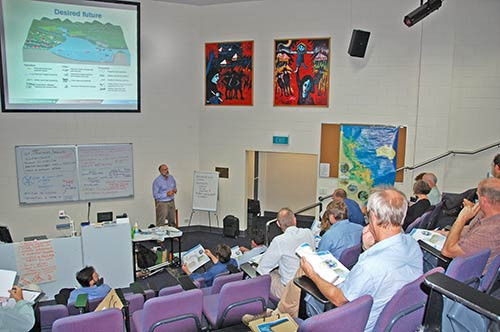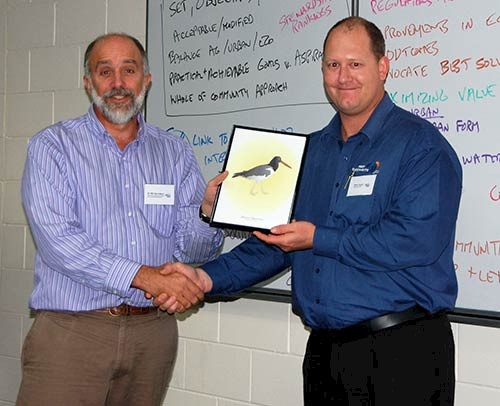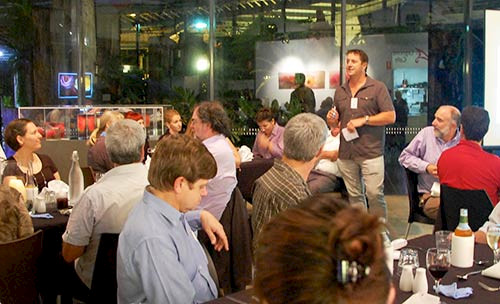Launching the Healthy Waterways Alliance in Mackay
Bill Dennison ·Sal Gray and Carl Mitchell from Reef Catchments invited me to participate in the launch of the Healthy Waterways Alliance in Mackay, on the central Queensland coast. We agreed on a plan for me come up the day before with a Science Communicator, Kate Moore, and run a half-day training session in which we would generate a draft newsletter. We would use the draft newsletter at the launch to structure a discussion about the form that Alliance would take. And then we would join the field trip on the following day to collect material for the newsletter.
The training session was conducted at Central Queensland University, Mackay. We had an introduction to science communication (me), an introduction to conceptual diagrams (Kate), followed by several rounds of Conceptionary, using topics designed for the region. We then broke into three working groups, 1) a Titles group to generate titles and subtitles for the newsletter, 2) Conceptual diagram group to draft an undesirable and a desirable future scenario, 3) a Key Messages group to draft bullet points for the text sections of the newsletter. That evening and the next morning, Kate, Carl and I took the material generated in the working groups and generated a first draft newsletter.
The formal part of the launch, also held at CQU, started with a short video about the Healthy Waterways Alliance, followed by a series of short speeches. The federal Member of Parliament for Capricornia, Kirsten Livermore, formally declared the meeting open. Kirsten talked about the need for a healthy and sustainable future. She was very supportive of the Healthy Waterways Alliance because she felt that the important thing was the community coming together to take ownership of their environmental issues. The next speaker, Peter McGinnity from the Great Barrier Reef Marine Park Authority, talked about the major challenges for the reef; a) water quality, b) coastal development and c) climate change, summarized in the Great Barrier Reef Outlook Report 2009. Peter also emphasized the importance of the Healthy Waterways Alliance in sharing information, aligning programs and combining resources. Rob Cocco, the CEO of Reef Catchments, provided an overview of the Healthy Waterways Alliance. He introduced the three think tanks; 1) agriculture, 2) urban and 3) ecosystems/water quality working on innovative approaches to achieve best practice stewardship for the Mackay-Whitsunday-Isaac region. Rob also mentioned the need to be both flexible and focused, and this seeming paradox represents the big challenge of environmental management.
Representatives from the three think tanks identified the major issues that they were going to tackle. Dr. Judith Wake from Central Queensland University talked about the ecosystems/water quality think tank and she introduced the ABCD ranking system that the various groups are using to rank various features. Bernie Cockayne from the Queensland Department of Environment and Resource Management talked about the O'Connell River case study and indicated the ABCD system could be applied to freshwater and estuarine rankings. Gert Nell from Isaac Regional Council talked about the urban think tank and he spoke about the economic drivers in the region being mining to the west and mining support along the coast. Scott Hardy from the Whitsunday Regional Council talked about developing ABCD scorecards for the urban regions and promoting water sensitive urban design. Peter Sutherland from BSES talked about the agriculture think tank, and introduced the group using a nice group photo. He also talked about 'spreading' innovation across the region by spreading mill mud (sugar cane processing residue) across the fields.
The final session was introduced by Mark Pascoe, CEO of the International WaterCentre, a consortium of four universities; University of Queensland, Griffith University, Monash University and University of Western Australia. Mark talked about the Healthy Waterways effort in Southeast Queensland in terms of the journey that the councils had embarked on and encouraged the Healthy Waterways Alliance to celebrate successes as well as celebrating the waterways and unique features of the region. Following this introduction, the Science Communication Workshop was reviewed with a short video and a PowerPoint summary. We distributed copies of the draft newsletter generated from the workshop and I facilitated a session in which we solicited input for the newsletter. This input included recommendations for major management activities, research priorities, and monitoring needs. The desired future scenario was refined and the unique features of the region were articulated.

At the end of the session, I presented Rob Cocco a framed version of the IAN symbol of the American Oystercatcher, so that the Healthy Waterways Alliance could have a memento of the Yank who came along for their launch.

We had a very nice reception and dinner at the Mackay Botanical Gardens, overlooking a lagoon where the water treatment plant for Mackay is situated. The Master of Ceremonies was Scott Hillier, the host of a popular television show called "Creek to Coast" on Channel Seven. Scott came down from his home in far north Queensland (Ingham) and regaled us with stories of his fishing adventures. Scott is a fishing enthusiast and it was clear that his enthusiasm that comes across on television is very real. Scott also encouraged various audience members to talk a bit about their involvement in waterways. Excellent food, an open bar, good stories and nice company meant that no one wanted to leave, and the patient staff at the Botanic Gardens was finally able to get us out of there late into the evening.

About the author
Bill Dennison

Dr. Bill Dennison is a Professor of Marine Science and Vice President for Science Application at the University of Maryland Center for Environmental Science.

